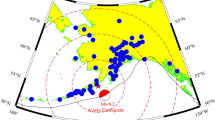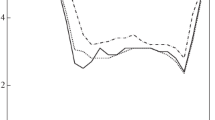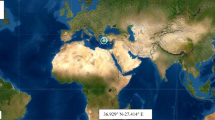Abstract
One of the more common methods of observation of variability of the Earth’s ionosphere is based on total electron content (TEC) estimated from ground-based dual-frequency Global Positioning System (GPS) receivers. Variations in solar, geomagnetic and seismic activity cause depletions or enhancements in the ionospheric electron concentrations that can be detected as disturbances. Some of these disturbances have wave-like characteristics, where frequency of oscillation can be used to identify and classify the disturbance. In this study, the frequency of such periodic disturbances is estimated using a fast Fourier transform (FFT)-based method, namely IONOLAB-FFT, in the spectral domain. IONOLAB-FFT, which was initially developed to be used on slant TEC (STEC), is modified to be applied to TEC in the local zenith direction of the receiver. The algorithm is tested using literature data on disturbances generated by a geomagnetic activity, a solar flare, a medium-scale traveling ionospheric disturbance (MSTID), a large-scale TID (LSTID) and an earthquake. An accordance with these known disturbances is observed in running IONOLAB-FFT, and the main frequencies and durations of the disturbances are estimated. IONOLAB-FFT method is applied to TEC computed from Turkish Permanent GPS Network (TNPGN-Active) which lies in mid-latitude region to detect the any wave-like oscillations, sudden disturbances and other irregularities during December, March, June and September months for 2010, 2011 and 2012 years. It is observed that a large number of the estimated frequencies are accumulated between 0.08 and 0.14 MHz corresponding to periods of 3.5 h to 2 h. The significant frequencies are grouped less than 0.28 MHz. A large number of the durations of the oscillations are between 425 and 550 min in 2010, 300 and 550 min in 2011 and 350 and 400 min in 2012. The longest duration (around 800 min: 13.33 h) is observed in December months, and the shortest duration (around 2 h) is observed in September months.

















Similar content being viewed by others
Data availability
All data sets used in this study are available from the references and relevant websites.
References
Afraimovich EL (2000) GPS global detection of the ionospheric response to solar flares. Radio Sci 35(N6):1417–1424
Arikan F, Yarici A (2017) Spectral investigation of traveling ionospheric disturbances: IONOLAB-FFT. Geodesy Geodyn 8(2017):297–304
Arikan F, Erol CB, Arikan O (2003) Regularized estimation of vertical total electron content from global positioning system data. J Geophys Res Space Phys 108(A12):1469–1480
Arikan F, Erol CB, Arikan O (2004) Regularized estimation of vertical total electron content from GPS data for a desired time period. Radio Sci 39(6):1–10
Arikan F, Arıkan O, Erol CB (2007) Regularized estimation of TEC from GPS data for certain mid-latitude stations and comparison with the IRI model. Adv Space Res 39:867–874
Arikan F, Nayir H, Sezen U, Arikan O (2008) Estimation of single station interfrequency receiver bias using GPS-TEC. Radio Sci 43(4):1–13
Arikan F, Sezen U, Toker C et al. (2016) Space weather studies of IONOLAB group. In: Proceedings of 2016 URSI Asia-Pacific radio science conference (URSI AP-RASC), Seoul, South Korea, August 2016, pp 1136–1139
Azpilicueta F, Brunini C, Radicella SM (2011) Semi-annual anomaly and annual asymmetry on TOPEX TEC during a full solar cycle. In: Proceedings of 2009 international-association-of-geodesy (IAG) scientific meeting, Buenos Aires, Argentine, July 2011, pp 769–774
Banks P, Kockarts G (1973) Aeronomy part B. Academic Press, San Diego
Basu S, Basu S, Valladares CE et al (2001) Ionospheric effects of major magnetic storms during the International Space Weather Period of September and October 1999: GPS observations, VHF/UHF scintillations, abd in situ density structures at middle and equatorial latitudes. J Geophys Res Space Phys 106(A12):389–413
Bergeot N, Chevalier JM, Bruyninx C et al (2014) Near real-time ionospheric monitoring over Europe at the Royal Observatory of Belgium using GNSS data. J Space Weather Space Clim 4(A31):1–10
Biqiang Z, Weixing W, Libo L, Tian M (2007) Morphology in the total electron content under geomagnetic disturbed conditions: results from global ionosphere maps. Ann Geophys 25(7):1555–1568
Brunini C, Camilion E, Azpilicueta F (2011) Simulation study of the influence of the ionospheric layer height in the thin layer ionospheric model. J Geodesy 85(9):637
Cherniak I, Zakharenkova I, Krankowski A (2014) Approaches for modeling ionosphere irregularities based on the TEC rate index. Earth Planets Space 66(165):1–5
Coster A, Williams J, Weatherwax A, Rideout W, Herne D (2013) Accuracy of GPS total electron content: GPS receiver bias temperature dependence. Radio Sci 48(2):190–196
Davies K, Baker DM (1965) Ionospheric effects observed around the time of the Alaskan earthquake of March 28, 1964. J Geophys Res 70(9):2251–2253
Davis MJ (1971) On polar substorms as the source of large-scale traveling ionospheric disturbances. J Geophys Res 76(19):4525–4533
Ding F, Wan W, Ning B, Wang M (2007) Large scale traveling ionospheric disturbances observed by GPS total electron content during the magnetic storm of 29–30 October 2003. J Geophys Res Space Phys 112(A6):1–15
Ding F, Wan W, Liu L, Afraimovich EL, Voeykov SV, Perevalova NP (2008) A statistical study of large-scale traveling ionospheric disturbances observed by GPS TEC during major magnetic storms over the years 2003–2005. J Geophys Res Space Phys 113(A3):1–8
Efendi E, Arikan F (2017) A fast algorithm for automatic detection of ionospheric disturbances: DROT. Adv Space Res 59(12):2923–2933
Erol CB, Arikan F (2005) Statistical characterization of the ionosphere using GPS signals. J Electromagn Waves Appl 19(3):373–387
Fedorenko YP, Fedorenko VN, Lysenko VN (2011) Parameters of the medium-scale traveling ionospheric disturbances model deduced from measurements. Geomagn Aeron 51(1):88–104
Fejer B, Farley D, Woodman R, Calderon C (1979) Dependence of equatorial F region vertical drifts on season and solar cycle. J Geophys Res 84(A10):5792–5796
Francis SH (1973) Acoustic-gravity modes and large-scale traveling ionospheric disturbances of a realistic, dissipative atmosphere. J Geophys Res 78(13):2278–2301
Gowtam SV, Ram ST (2017) Ionospheric annual anomaly—New insights to the physical mechanisms. J Geophys Res Space Phys 122(8):8816–8830
Hargreaves JK (1992) The solar-terrestrial environment. Cambridge University Press, Cambridge
Hernandez-Pajares M, Juan JM, Sanz J (2006) Medium-scale traveling ionospheric disturbances affecting GPS measurements: spatial and temporal analysis. J Geophys Res Space Phys 111(A7):1–13
Ho CM, Mannucci AJ, Sparks L et al (1998) Ionospheric total electron content perturbations monitored by the GPS global network during two northern hemisphere winter storms. J Geophys Res Space Phys 103(A11):26409–26420
Hocke K, Schlegel K (1996) A review of atmospheric gravity waves and travelling ionospheric disturbances: 1982–1995. Ann Geophys 14(9):917–940
Hsiao CC, Liu JY, Oyama KI et al (2010) Seismo-ionospheric precursor of the 2008 Mw7.9 Wenchuan earthquake observed by FORMOSAT-3/COSMIC. GPS Solut 14(1):83–89
Husin A, Abdullah M, Momani MA (2011) Observation of medium scale traveling ionospheric disturbances over Peninsular Malaysia based on IPP trajectories. Radio Sci 46(2):1–10
IONOLAB. www.ionolab.org
Jakowski N, Beniguel Y, De Franceschi G et al (2012) Monitoring, tracking and forecasting ionospheric perturbations using GNSS techniques. J Space Weather Space Clim 2(A22):1–14
Jianyong L, Guojie M, Xinzhao Y, Rui Z, Hongbo S, Yufei H (2015) Ionospheric total electron content disturbance associated with May 12, 2008, Wenchuan earthquake. Geodesy Geodyn 6(2):126–134
Jin S, Zhu W, Afraimovich E (2010) Co-seismic ionospheric and deformation signals on the 2008 magnitude 80 Wenchuan Earthquake from GPS observations. Int J Remote Sens 31(13):3535–3543
Karatay S, Arikan F, Arikan O (2010) Investigation of TEC variability due to seismic and geomagnetic disturbances in the ionosphere. Radio Sci 45(5):1–12
Karatay S, Cinar A, Arikan F (2017) Ionospheric responses during equinox and solstice periods over Turkey. Adv Space Res 60(9):1958–1967
Katamzi ZT, Smith ND, Mitchell CN, Spalla P, Materassi M (2012) Statistical analysis of travelling ionospheric disturbances using TEC observations from geostationary satellites. J Atmos Solar Terr Phys 74:64–80
Kil H, Paxton LJ, Pi X, Hairston MR, Zhang Y (2003) Case study of the 15 July 2000 magnetic storm effects on the ionosphere-driver of the positive ionospheric storm in the winter hemisphere. J Geophys Res 108(A11):1–22
Klobuchar JA (1987) Ionospheric time-delay algorithm for single-frequency GPS users. IEEE Trans Aerosp Electron Syst AES 23(3):325–331
Krankowski A, Shagimuratov II, Baran LW, Ephishov II (2005) Study of TEC fluctuations in Antarctic ionosphere during storm using GPS observations. Acta Geophys Polon 53(2):205–218
Krankowski A, Shagimuratov II, Baran LW, Ephishov II, Tepenitzyna NJ (2006) The occurrence of polar cap patches in TEC fluctuations detected using GPS measurements in southern hemisphere. Adv Space Res 38(11):2601–2609
Lastovicka J (2009) Lower ionosphere response to external forcing: a brief review. Adv Space Res 43(1):1–14
Ledvina BM, Makela JJ, Kintner PM (2002) First observations of intense GPS L1 amplitude scintillations at mid-latitude. Geophys Res Lett 29(14):1–4
Lin JW (2014) Ionospheric precursor of 2008 China Wenchuan earthquake using two-dimensional principal component analysis. HKIE Trans 21(3):192–194
Liu JY, Chuo YJ, Shan SJ et al (2004) Pre-earthquake ionospheric anomalies registered by continuous GPS TEC measurements. Ann Geophys 22(5):1585–1593
NASA’s Goddard Space Flight Center. ftp://cddis.gsfc.nasa.gov/gps/products/ionex/
Nayir H, Arikan F, Arikan O, Erol CB (2007) Total electron content estimation with Reg-Est. J Geophys Res Space Phys 112(A11):1–11
Nicolls MJ, Kelley MC, Coster AJ, Gonzlez SA, Makela JJ (2004) Imaging the structure of a large-scale TID using ISR and TEC data. Geophys Res Lett 31(9):1–4
Ohki M, Zervakis ME, Venetsanopoulos AN (1995) 3-D Digital filters. Control Dyn Syst 69:49–88
Pi X, Mendillo M, Hughes WJ et al (2000) Dynamical effects of geomagnetic storms and substorms in the middle-latitude ionosphere: an observational campaign. J Geophys Res 105(A4):7403–7417
Prieto-Cerdeira R, Orús Pérez R, Breeuwer E, Lucas-Rodriguez R, Falcone M (2014) Performance of the Galileo single-frequency ionospheric correction during in-orbit validation. GPSworld 25:53–58
Pulinets SA, Contreas AL, Bisiacchi-Giraldi G, Ciraolo L (2005) Total electron content variations in the ionosphere before the Colima, Mexico, earthquake of 21 January 2003. Geofís Int 44(4):369–377
Pulinets SA, Kotsarenko AN, Ciraolo L, Pulinets IA (2007) Special case of ionospheric day-to-day variability associated with earthquake preparation. Adv Space Res 39(5):970–977
Rishbeth H, Garriott OK (1969) Introduction to ionospheric physics. Academic Press, New York
Rishbeth H, Mendillo M (2001) Patterns of F2-layer variability. J Atmos Solar Terr Phys 63(2001):1661–1680
Rishbeth H, Muller-Wodarg CF, Zou L et al (2000) Annual and semiannual variations in the ionospheric F2-layer: II Physical discussion. Ann Geo Phys 18:945–956
Roma-Dollase D, Hernández-Pajares M, Krankowski A et al (2018) Consistency of seven different GNSS global ionospheric mapping techniques during one solar cycle. J Geodesy 92:691–706
Russian Academy Sciences Izmiran. https://www.izmiran.ru/ionosphere/weather/storm/
Sagir S, Karatay S, Atici R, Yesil A, Ozcan O (2015) The relationship between the Quasi Biennial Oscillation and Sunspot Number. Adv Space Res 55(1):106–112
Sardon E, Rius A, Zarraoa N (1994) Ionospheric calibration of single frequency VLBI and GPS observations using dual GPS data. J Geodesy 68(4):230–235
Sayin I, Arikan F, Akdogan KE (2010) Optimum temporal update periods for regional ionosphere monitoring. Radio Sci 45(6):1–9
Sezen U, Arikan F, Arikan O, Ugurlu O, Sadeghimorad A (2013) Online, automatic near-real time estimation of GPS-TEC: IONOLAB-TEC. Space Weather 11(5):297–305
Shiokawa K, Ihara C, Otsuka Y, Ogawa T (2003) Statistical study of nighttime medium-scale traveling ionospheric disturbances using mid-latitude airglow images. J Geophys Res Space Phys 108(A1):1–7
Song Q, Ding F, Yu T et al (2015) GPS detection of the coseismic ionospheric disturbances following the 12 May 2008 M79 Wenchuan earthquake in China. Sci China Earth Sci 58(1):151–158
Space Research Center. ftp://ftp.cbk.waw.pl/idce/quiet_days/q_d_days.ctl
Space Weather Live. https://www.spaceweatherlive.com/en/archive/2017/09/06/xray
Space Weather Prediction Center. ftp://ftp.swpc.noaa.gov/pub/indices/old_indices/ftp://ftp.swpc.noaa.gov/stp/space-weather/solar-data/solar-indiceshttp://satdat.ngdc.noaa.gov/
Sripathi S, Balachandran N, Veenadhari B, Singh R, Emperumal K (2013) Response of the equatorial and low-latitude ionosphere to an intense X-class solar flare (X7/2B) as observed on 09 August 2011. J Geophys Res Space Phys 118:2648–2659
Stankov SM, Warnant R, Stegen K (2009) Trans-ionospheric GPS signal delay gradients observed over mid-latitude Europe during the geomagnetic storms of October–November 2003. Adv Space Res 43(9):1314–1324
Tsugawa T, Otsuka Y, Coster AJ, Saito A (2007) Medium-scale travelling ionospheric disturbances detected with dense and wide TEC maps over North America. Geophys Res Lett 34(22):1–5
Tsurutani B, Judge DL, Guarnieri FL et al (2005) The October 28, 2003 extreme EUV solar flare and resultant extreme ionospheric effects: comparison to other Halloween events and the Bastille Day event. Geophys Res Lett 32(L03S09):1–4
U.S. Geological Survey. https://earthquake.usgs.gov/earthquakes
Vlasov M, Kelley MC (2000) Kil H (2003) Analysis of ground-based and satellite observations of F-region behavior during the great magnetic storm of July 15. J Atmos Solar Terr Phys 65(11–13):1223–1234
Wang M, Ding F, Wan W, Ning B, Zhao B (2007) Monitoring global traveling ionospheric disturbances using the worldwide GPS network during the October 2003 storms. Earth Planets Space 59(5):407–419
World Data Center For Geomagnetism, Kyoto. https://wdc.kugi.kyoto-u.ac.jp/dstdir/
Yasyukevich Y, Astafyeva E, Padokhin A, Ivanova V, Syrovatskii S (2018) The 6 September 2017 X-class solar flares and their impacts on the ionosphere, GNSS, and HF radio wave propagation. Space Weather 16(8):1013–1027
Yuan Y, Ou J (2001a) Auto-covariance estimation of variable samples (ACEVS) and its application for monitoring random ionospheric disturbances using GPS. J Geodesy 75:438–447
Yuan Y, Ou J (2001b) An improvement to ionospheric delay correction for single-frequency GPS users—the APR-I scheme. J Geodesy 75:331–336
Yuan Y, Wang N, Li Z, Huo X (2019) The BeiDou global broadcast ionospheric delay correction model (BDGIM) and its preliminary performance evaluation results. NAVIGATION 66:55–69
Zhang DH, Xiao Z (2003) Study of the ionospheric total electron content response to the great flare on 15 April 2001 using the International GPS Service network for the whole sunlit hemisphere. J Geophys Res Space Phys 108(A8):1–11
Zhang X, Xie W, Ren X, Li X, Zhang K, Jiang W (2017) Influence of the GLONASS inter-frequency bias on differential code bias estimation and ionospheric modeling. GPS Solut 21(3):1355–1367
Zhang B, Teunissen PJG, Yuan Y, Zhang X, Li M (2018) A modified carrier-to-code leveling method for retrieving ionospheric observables and detecting short-term temporal variability of receiver differential code biases. J Geodesy 93:19–28
Acknowledgements
This study is supported by TUBITAK 114E541, 115E915 and joint TUBITAK 114E092 and AS CR 14/001 projects. The GIM-TEC, Satellite DCB and ephemeris data that are used in computation of IONOLAB-TEC are obtained from IGS Analysis Center of Jet Propulsion Laboratory (JPL) at ftp://cddis.gsfc.nasa.gov/pub/gps/products/ionex. TNPGN-Active RINEX data set is made available to IONOLAB group for TUBITAK 109E055 project. This data set can be accessed by the permission from TUBITAK and General Command of Mapping of Turkish Army at https://www.hgk.msb.gov.tr/. The SSN data, Kp and Ap indices are obtained from National Oceanic and Atmospheric Administration (NOAA), U.S. Department of Commerce at ftp://ftp.swpc.noaa.gov/pub/indices/old_indices/. Earthquake information is obtained from https://earthquake.usgs.gov/earthquakes. AE and Dst indices are obtained from https://wdc.kugi.kyoto-u.ac.jp/. The TEC storm catalogs are obtained from Ionospheric Weather website of IZMIRAN at https://www.izmiran.ru/ionosphere/weather/storm/. The author is grateful to anonymous reviewers for their comments and contributions, which have been very helpful and constructive for the authors in improving the paper. Finally, the author wishes to thank Prof. Dr. Feza Arikan and IONOLAB group for their outstanding efforts on IONOLAB-BIAS and IONOLAB-TEC Algorithm.
Author information
Authors and Affiliations
Corresponding author
Rights and permissions
About this article
Cite this article
Karatay, S. Estimation of frequency and duration of ionospheric disturbances over Turkey with IONOLAB-FFT algorithm. J Geod 94, 89 (2020). https://doi.org/10.1007/s00190-020-01416-1
Received:
Accepted:
Published:
DOI: https://doi.org/10.1007/s00190-020-01416-1




